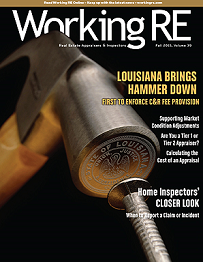 |
>> See Past News Editions >> Click to Print> 2016-2017 TAF Approved USPAP Online Enroll Now! (7 hours – $143.95) |
Appraiser/Whistleblower Wins $85 Million
By Isaac Peck, Editor
In what many see as a win for appraisers, as well as those lenders and appraisal management companies (AMCs) that do follow the law, Fifth Third Bank has agreed to pay nearly $85 million as part of a settlement with the U.S. Department of Justice (DOJ). The case deals primarily with fraudulent appraisal practices. The lead whistleblower in the case is George Mann, Fifth Third’s former chief appraiser.
The settlement is the latest in a string of appraiser whistleblower lawsuits that highlight unethical and fraudulent practices that violate appraiser independence and perpetuate appraisal fraud. Mann follows in the footsteps of Kyle Lagow, of Countrywide, who received $14 million in a whistleblower case that led to a $1 billion settlement between Bank of America (BoA) and the DOJ, and Robert Madsen, who received $56 million for his part in a $16.65 billion settlement, also with BoA. (See Interview: Appraiser Who Brought Down Countrywide, visit WorkingRE.com; click Library.)
Mann, and his co-claimant John Ferguson, will receive seven and one-half percent (7.5%) for their part in the Fifth Third suit as whistleblowers, which calculates to a tidy $6,368,326, before lawyers’ fees and taxes. The lawsuit was filed under the qui tam or whistleblower provisions of the False Claims Act, which allows private parties to sue on behalf of the United States when they believe a company has submitted false claims for government funds.
Mann declined to comment for this story. Mann’s initial complaint was filed in June 2011, meaning that it took over four years to finally reach a settlement. Throughout the struggle, Mann writes that he often listened to Tom Petty’s song “I won’t back down,” advising appraisers to “give it a listen anytime someone wants you to compromise your ethics.”
Fraud, Pressure and Fees
Similar to other high-value whistleblower settlements, large portions of the case have been sealed by the order of a federal judge. However, Mann’s amended complaint remains public and contains many scenarios that will surely sound familiar to appraisers.
Mann was hired in 2004 to be Chief Appraiser and Vice President of the Real Estate Valuation Group (REVG), the valuation arm of Fifth Third Bank. His tenure lasted until September 2008 when he was terminated.
While the initial suit focuses on commercial appraisals and commercial loans, it also alleges that fraudulent and misleading appraisals were used by Fifth Third to qualify for funding from the Troubled Asset Relief Fund (TARP), the Federal Deposit Insurance Corporation (FDIC), Fannie Mae, Freddie Mac, and other federal funding and securitization programs.
(story continues below)

(story continues)
The practices described in the suit reflect the worst of the industry’s abuses, echoing the same issues that appraisers continue to encounter and speak out about today: pressure to meet value, unreasonable turn times and low fees. According to the suit: “From 2004 through today, loan officers instructed, coerced, and/or intimidated staff into obtaining appraisals at below-market fees and with unrealistically short delivery times, which resulted in questionable valuations. In addition, lenders used the same methods of intimidation to pressure REVG staff and/or appraisers into raising values so loan conditions could be met.”
According to the suit, as part of its scheme to commit appraisal fraud, Fifth Third also allowed loan personnel to close loans prior to the completion of an appraisal, hand-select favored appraisers at times, and retaliate against impartial appraisers when they would not value properties high enough.
Mann began reporting Fifth Third’s violations to the Federal Reserve in 2005 and continued sending reports until 2008 when he was terminated, according to the suit. Mann and Ferguson estimated that the degree of overvaluation was at least 20 percent of the Bank’s $20 billion commercial real estate loan portfolio, causing Fifth Third’s loan portfolio to be overvalued by $4 billion.
This overvaluation, according to the suit, means that Fifth Third misrepresented its financial position and consequently defrauded the Federal Reserve, the United States Treasury, Fannie Mae, Freddie Mac, and the Federal Housing Administration.
Federal Reserve
While most appraisers are familiar with the typical motivations that cause pressure on an appraiser to “close the deal,” the suit offers a fresh look at another reason banks are motivated to overvalue their collateral. Specifically, the suit alleges that the misleading and overvalued appraisals were used, in part, as a mechanism for reducing Fifth Third’s reserve obligations for the Federal Reserve.
For instance, if a bank reports to the Federal Reserve that its loans are well collateralized and of low risk, the Federal Reserve then allows the bank to keep a lower amount on reserve. On the other hand, if a bank’s loans are under-collateralized and the risk is high, the Federal Reserve requires the bank to hold more money in reserve to protect the government’s interests.
Consequently, banks that want to reduce their reserve obligations and have more cash on hand, have a motivation to actively over-report the value of their loan portfolios, as this lowers the amount that the Federal Reserve requires to be placed in reserve.
This, the suit alleges, is exactly what Fifth Third did, systematically procuring “erroneous and inflated” values which caused the Federal Reserve to underestimate the bank’s risk and allowed the bank to reduce its reserves.
(story continues below)
Case Development
Of interest to many who read this settlement closely is the fact that John Ferguson was named as a co-claimant in the suit and received a portion of the $6.34 million whistleblower settlement, despite the fact that Ferguson never worked at Fifth Third Bank. Ferguson is a self-described “career whistleblower” who initially filed a whistleblower lawsuit against Bank United in the early 2000s. While his whistleblower lawsuit was not successful due to Bank United declaring bankruptcy, Ferguson learned so much about the process that he decided to become a fulltime whistleblower, helping others build cases against big banks and other organizations that have defrauded the government.
Ferguson says he brings experience to the process. “I call myself a professional whistleblower. I help put all the bits of information together so that it all fits in this kind of lawsuit. It’s a long and painful process,” says Ferguson.
The case developed from a suit primarily focused on commercial appraisals, and yet it culminated in a settlement over residential FHA loans. Ferguson says one of the reasons for this may be the complexity of the commercial loans and appraisals. “George and I have been the only whistleblowers who filed on commercial lending. The government already understood the residential side, but I don’t think they were as familiar with the commercial side. It was a little disappointing because commercial real estate was hit just as hard as residential,” says Ferguson.
Ultimately, the government decided to focus on residential lending, discovering that hundreds of FHA loans were too defective to qualify for FHA insurance. The $85 million settlement with Fifth Third compensates the government for over 1,400 loans that were insured through the FHA loan program and were discovered to be defective.
Being a Whistleblower
While the prospect of million dollar settlements sounds enticing to many, the reality of being a whistleblower is not pretty. Whistleblowers frequently speak of a long and lonely struggle for justice, including being forbidden from discussing the suit with anyone, including immediate family or friends.
Ferguson says that being a whistleblower is not for everyone. “It’s hard to sit there for four or five years sometimes, not knowing if you’re going to get anything out of it or not. A whole host of negative things can happen to a whistleblower, including getting blackballed by the industry,” says Ferguson.
For those appraisers who are aware of lenders or other organizations that are brazenly violating the law and are interested in blowing the whistle, Ferguson points out that success is all about documentation. “It can’t just be your word. The government has to have a lot of documentation before they will get involved: people, places, and things. When did it happen, who did it, how did it happen, why is it wrong, to what extent is it wrong, and what damages might there be to the government? Appraisers witnessing wrongdoing would be wise to save everything: appraisals, emails, phone numbers, you name it,” says Ferguson.
The fact that Mann had such detailed and quality documentation on the fraud was a critical element that helped the Fifth Third case succeed, according to Ferguson.
Lastly, Ferguson says appraisers who are interested in blowing the whistle should consult with an attorney. “There are a lot of whistleblower attorneys who will take your call if you believe you have a case. You just need to know how to talk to them about it. I’d be happy to talk to appraisers and lead them in the right direction, maybe point them towards a lawyer,” says Ferguson.
Linda J. Stengle, a whistleblower attorney who was involved in the case, encourages appraisers to step forward. “The False Claims Act, and to a lesser extent, the SEC whistleblower program, can really help protect qualified appraisers who are doing their jobs properly. Appraisers who are aware of large scale USPAP and FHA violations, for example, should investigate whether a whistleblower action will work for them.”
Appraisers on Frontline
Even inside the industry, appraisers are frequently blamed for going along with the widespread fraud that contributed to the real estate bubble and crash of the early 2000s. However, the Fifth Third settlement is a reminder that appraisers have often been on the frontlines in the fight against real estate and mortgage fraud. Like Kyle Lagow or George Mann, the rank-and-file appraiser frequently stands alone against illegal pressure and is too often the lone voice of integrity defending the public trust. Lately, appraisers seem to be the ones blamed for the failures and fraud on the part of lenders that led to the real estate collapse.
Richard Hagar, SRA trains lenders and AMCs on policies and procedures, as well as helping residential appraisers understand their rights. Hagar believes the settlement is good for the industry because it shows that there are consequences when banks violate the law. “Appraisers are often bullied and pushed around. The whistleblower statute, which was reinforced under Dodd-Frank, gives appraisers some muscle to stand up to bullies,” says Hagar.
Hagar continues, “Appraisers have been on the frontlines of many of the whistleblower lawsuits regarding real estate fraud that have been made public, and I can tell you that multiple whistleblower cases involving appraisers are currently ongoing. Appraisers don’t win every case and we often only hear about the victorious ones since qui tam suits are filed under seal. Even still, fighting back against these illegal practices is the only way we can stop this,” Hagar said.
Here’s to those appraisers who refuse to compromise and “won’t back down.”
This November!
Dates: November 10th and 17th
Appraiser Adjustments: Solving Common Problems – By: Richard Hagar, SRA
Failure to provide proof and analysis to support your adjustments means a rough road from now on out. In this upcoming two-part webinar, Richard Hagar, SRA shares the most common methods that can be used for determining adjustments and shows examples of how it applies to numerous components throughout an appraisal. Hagar will work through many examples, explaining how to calculate adjustments in the “real world.” Learn to apply regression analysis within different neighborhoods as well as how to use the right adjustment method on duplexes, multifamily, condos, and waterfront property. Sign Up Now!
Fall Webinar Schedule
• Fannie Mae and Q&C Ratings – Richard Hagar, SRA (Oct. 2 parts)
• Appraisal Adjustments – Solving Common Problems – Richard Hagar, SRA (Nov. 2 parts)
• How to Create a Proper Reconciliation – Tim Andersen, MAI (available now)
• Claims, Complaints, and E&O Insurance – David Brauner (available now)
Season Ticket: $129 (Save 35% on all six webinars)
Save $78: Get the Season Ticket
About the Author
Isaac Peck is the Editor of Working RE magazine and the Director of Marketing at OREP.org, a leading provider of E&O insurance for appraisers, inspectors and other real estate professionals in 49 states. He received his Master’s Degree in Accounting at San Diego State University. He can be contacted at Isaac@orep.org or (888) 347-5273.
>Click to Print
>New: Collateral Underwriter Blog: Find answers, offer solutions.
>Opt-In to Working RE Newsletters
Send your story submission/idea to the Editor: isaac@orep.org



by John Ferguson
I’ve lost a lot of business by just saying no… If the appraisal industry really wants change the just say no to low fees and inappropriate requests.
-by John O'Connor
Now I am really depressed; of all people to win a large lawsuit, George Mann. The guy who wants to get rid of the sales comparison approach and get rid of appraisers so the banks will have to use his Valuist valuation program. Ughhh!
-by Matt
Not paying reasonable fees has been happening since the HVCC and continues. AMCs, Fannie, regulators, state regulators are all to blame. Who’s Blowing that whistle?
-by Mike Ford, CA AG; SCREA,AGA,GAA,RAA
Matt; The Louisiana Real Estate Appraisers Coalition (LREAC) has been blowing that whistle and are reported to have ‘caught’ Coester VMS. North Carolina also caught them and it appears Virginia has, or is in the process of doing so.
Generically, the American Guild of Appraisers (AGA, OPEIU/AFL-CIO) has also been sounding that alarm, and more importantly is taking steps to fight & eventually STOP the ongoing abuse. Our proposal can be read athttp://mfford.com/html/c___r_fees.htm
We sent the FFIEC and CFPB a letter related to the appraisal deficiencies arising from TRID, only two days ago.
Folks, few of us are in a position to do what these courageous individuals did, but that does not mean we cannot make just as meaningful, and perhaps even longer lasting impact. The long term solution to C&R ( term that has become an oxymoron in itself) is with all due respect to the state coalitions, in Washington DC-rather than the individual states. Only 33 states even HAVE AMC regulations; of those FAR FEWER have any provision for even addressing C&R. In MY state (California) the official website of BREA simply tells the appraiser to contact CFPB.
These folks have proven to us that it CAN be done. Now it is up to us to actually do something about it.
OK, then let’s DO something! COME JOIN US in “contacting” CFPB! Join the AGA today. Contact janbellas@appraisersguild.org or by calling 1-(301) 220-4100
-by Mike Ford, CA AG; SCREA,AGA,GAA,RAA
http://mfford.com/html/c___r_fees.htm
-Typo, sorry.
by Rachel Massey
So good to see speaking up and calling foul pays!
-by Lauren Willis
To: Isaac Peck
Thank you for this article from all appraisers with integrity!!
-